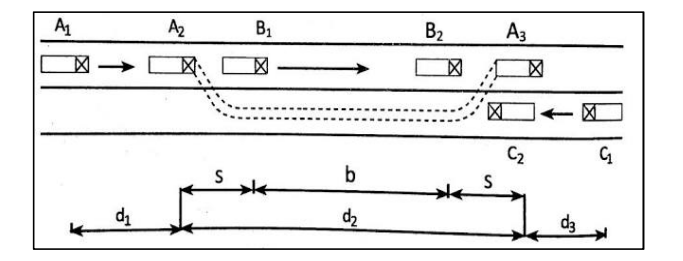
The following are the suppositions used to determine the values of d1, d2, and d3 (m):
- Until there is a chance for a safe overtaking operation, the overtaking vehicle A is compelled to slow down from its design speed of v (m/sec) to Vb (m/sec) of the slow vehicle B and move behind it, leaving a spacing of s (m).
- The vehicle A goes at a speed of vb (m/sec) via a distance of d1 from position A1 to A2 when the driver of vehicle A detects a sufficient clear gap ahead and decides within a response time t (sec) to accelerate and pass the vehicle B.
- In the time T (sec) between positions A2 and A3, the vehicle A accelerates and passes the slower vehicle B within a distance d2. The distance d2 is divided into three pieces.
- The distance travelled by the slow vehicle B between B1 and B2 during the overtaking manoeuvre of A;
- The spacing, s (m), between A2 and B1 The vehicle C approaching from the opposite direction moves over a distance of d3 from position C1 to C2 during this overtaking period T (sec).
- Spacing (m) between B2 and A3.
Determination of the components of OSD
- From point A1 to A2, the distance, d1, travelled by vehicle A after passing it at a slower speed, vb, during the reaction time, t, is equal to vb t. (m). The IRC advises that as the driver’s primary goal is to locate an opportunity to overtake, the reaction time t may be considered as an average value of 2.0 sec. As a result, d1 = 2vb.
- In position A3, ahead of B, vehicle A accelerates from position A2, moves to the next lane, passes vehicle B, and then returns to its original lane during the overtaking time, T. (sec). The straight line between positions A2 and A3 is calculated as d2 (m), which is then divided into three components, d2 = (s + b + s).
- The minimal separation s (m) between the two vehicles while driving at the speed vb (m/sec) may be determined as the minimum distance between positions A2 and B1. The empirical formula s = (0.7 vb + 6) determines the minimal distance between vehicles in relation to their speed.
- The time T now depends on the speed of the overtaking vehicle B and its average acceleration (m/sec2), a. By applying the basic formula for the distance travelled by a uniformly accelerating body with beginning speed vb m/sec and an is the average acceleration during overtaking in m/sec2, d2 = (vb T + 2s), it is possible to compute the overtaking time T (sec).
- When vehicle A is being overtaken, or during time T (sec), the distance travelled by vehicle C driving at design speed v (m/sec) equals the distance d2 (m) between positions C1 and C2.Thus, d3 = v T. (m)In units of m/sec.
OSD = (d1 + d2 + d3) = (vb t + vb T + 2s + vT)
Here, vb = initial speed of overtaking vehicle, m/s
t = reaction time of driver = 2 sec
V = speed of overtaking vehicle or design speed, kmph
T = √4s/A
s = spacing of vehicles = (0.7 vb + 6)
a= average acceleration during overtaking, m/sec.
In kmph units
